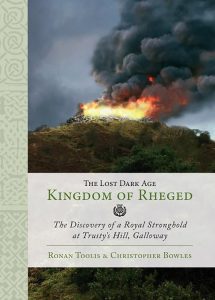The Lost Dark Age Kingdom of Rheged: The Discovery of a Royal Stronghold at Trusty’s Hill, Galloway, by Ronan Toolis and Christopher Bowles, Oxbow Books: Oxford and Philadelphia, 2017. vi+169pp. ISBN 978-1-78570-311-9. Reviewed by Dr. Roger Collins.
As reported here, the two campaigns of excavation covered no more than 2.6% of the total site (p 13), with that of 2012 being restricted to only 1.3%. The  chronology suggested by the first excavators, of an initial short occupation in the 4th century BC, followed, after an interval of abandonment, by a second phase in the post-Roman period, has been fully confirmed by the second. Carbon dating and other forms of analysis described here imply that this later period of use began no earlier than the late 5th century, and ended in the early 7th, probably by c 630.
chronology suggested by the first excavators, of an initial short occupation in the 4th century BC, followed, after an interval of abandonment, by a second phase in the post-Roman period, has been fully confirmed by the second. Carbon dating and other forms of analysis described here imply that this later period of use began no earlier than the late 5th century, and ended in the early 7th, probably by c 630.
This report of the 2012 excavation testifies to some of the clear strengths of current archaeological practice in Britain, but also to some of its problems. On the positive side is the very detailed and thorough investigation recorded here, represented by the scientific dating (chapter 3), the careful analysis of artefacts (chapter 4) and the presentation of the environmental evidence (chapter 5). These chapters and sections within them are contributed by a distinguished group of specialists. Amongst the most substantial is chapter 6, which is devoted to the rock carvings. These are all found on a single large stone and range from modern graffiti and a supposed Ogham inscription (here denied) to two Pictish style figures, one a ‘double disc and Z-rod’ and the other a beast partly impaled upon an edged weapon. Close analysis of these two symbols, placed either side of a natural divide in the rock, suggests that they are neither of Pictish creation nor date, but belong to a later phase in the history of the site, probably the 9th century.
It is highly surprising to find this evidence being explicitly rejected by the two lead authors of the report in their general discussion of the results (Chapter 7), because it does not fit their favoured interpretation of the site as a royal centre. This is a claim based on extremely slender foundations, depending not least on the idea that royal inaugurations were staged here; seemingly in or by a pond behind a cattle pen. This particular argument requires the seemingly Pictish symbols, referred to above, to date to the period of occupation of the vitrified fort, ie before c 630 at the latest. However, even if genuine, they could not be so early. Instead of engaging in argument on this, the two authors try to discredit the testimony of their chosen experts by means of more generalised comparisons with other supposedly royal sites, whose own interpretation may be equally open to question.
It has to be said that, however eloquently the authors paint their picture of ‘Rheged, with Trusty’s Hill at its secular heart, Whithorn as it religious centre, Taliessin its poetic master and Urien its most famous king’ (p 152) an excavation extending to no more than 1.3% of this small site is hardly strong enough to bear such an interpretation, especially as evidence for structures extends little beyond two likely post holes. A priori interpretations based on the evidence of metal working and imported pottery on the site may confirm that its owners belonged to the social elite of the kingdom, but its royal status must be judged unproven, or even unlikely.
It may be wondered if the threat of over confident interpretation of results is caused by the timidity of the public bodies in charge of archaeological research in this country, who limit excavators to small interventions, or even, as in this case, to merely going over old ground again. Knowing, too, that permission for further work on this site is unlikely to be given for decades to come, the temptation must be to try to give clear and definitive results now, however questionable their foundations. This matters greatly, as the conclusions reached will spread far more widely and generally than the detailed evidential base upon which they should rest, but which when examined closely may qualify them. For the sake of scholars in related disciplines and of the interested general public, caution and uncertainty must be placed before confident claims based on too little evidence.
Dr. Roger Collins is an Honorary Fellow of the School of History, Classics & Archaeology at the University of Edinburgh.
